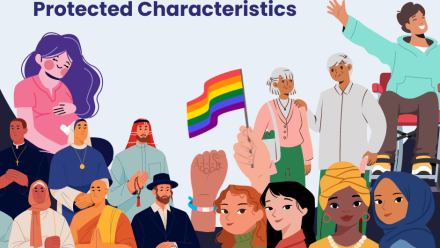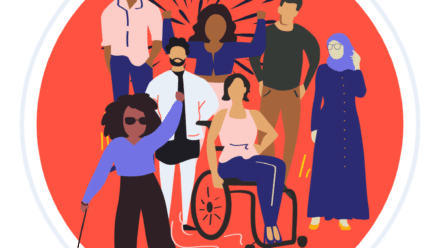Why diversity and inclusion is the answer to employee engagement
12th April 2021 by Ellie Thompson
Successful employee engagement can make your organisation. Engaged employees mean a team that bring fresh ideas, feel safe and happy at work, and have space to reach their full potential in the workplace. But how can you create a work environment where employees are truly engaged?
The answer? Focus on diversity and inclusion. We’ll show you how a diverse and inclusive organisation is the key to successful employee engagement.

An employee engagement strategy as diverse as your employees
You know that your employees are diverse in every way imaginable; background, working style, communication preference, hobbies, comfort zones… In order to improve employee engagement, you need an approach that welcomes this difference and includes all.
You can’t risk only including, and therefore engaging, one type of employee.
So, what can you do to engage everyone?
Don’t focus on one ‘easy win’ strategy. Some employees feel most engaged by more structured internal communications, such as transparent insight into organisational updates, and satisfaction surveys to measure job satisfaction. For others, the key is to ensure their working life feels balanced, by creating social and communal spaces for social events from group lunches, to bake-offs, to evening drinks. And some may only truly feel engaged if they have space for 1:1 support, such as wellbeing mentoring or workplace coaching or regular performance management.
So don’t approach employee happiness thinking that one size fits all; to support diverse employees, you’ll need to use diverse tactics.
Make sure every employee feels safe to truly ‘show up’
Disengaged employees will still turn up to do their job, clocking in and out, and coming along to meetings. They may even attend workplace social events or contribute to recreational activities. But this isn’t really measuring engagement. You may be missing the opportunity to make the workplace a truly safe and engaging space for your employees, and therefore missing out on the full potential of your workforce.
Even in a workplace that talks of diversity and inclusion, people often feel the need to mask aspects of themselves. Especially if such aspects create disabling barriers, such as disability, neurodiversity, class, sexual orientation, or other aspects of their identity that have, historically, not been safe to share.
We love campaigns like Mental Health First Aid England’s #MyWholeSelf for shining a light on how important it is for employees to feel safe to bring their whole selves to work. But taking on such campaigns would be meaningless without a real investigation into why people may not feel safe to be their true selves at work, and what organisations can do to fix this. As our CEO Atif says:
“Many people who are marginalised by these different forms of oppression will only come forward and bring their whole selves to work when we explicitly show them that they count. We must demonstrate we are doing all we can to break down the barriers they face. This means being overtly anti-racist, calling out misogyny and celebrating diversity in all it’s forms. When we build workplaces that illustrate our commitment to equality, fairness and respect, then we will start to change the tide.”
You can read more about how building equity around race, class and culture allows all of us to bring our whole selves to work in Atif’s blog.
Open, inclusive and engaged leadership forms a powerful example
One of the clearest signs of a disengaged workforce is leadership that seem similarly disengaged, or at least disconnected, from their team. Signs of stress from the top such as presenteeism, overworking, and withdrawal will ripple down and affect every level of employee.
It’s absolutely vital that your employee engagement includes every employee in every sphere of your organisation. Lead by example by taking time off when you need, being vocal about your challenges and successes, and joining in on team initiatives and social activities. Soon, your employees will feel safe to do the same, workplace stress will reduce, employees will have the time and space to work to their full potential, and employee satisfaction will improve.
Anticipate diversity, include from the offset, and improve employee engagement
You can take such simple steps to reduce the disabling barriers of your organisation’s work environment.
Often, workplaces are prepared, even happy, to make the legally required reasonable adjustments when an employee requests them. But meeting the legal requirement is the bare minimum. As we like to say “compliance means you don’t get sued. It doesn’t mean you include.”
Instead, create an anticipatory culture where employees don’t have to disclose differences to access reactive adaptations but can instead take advantage of inclusive options available to everyone. This includes everything from flexible hours and remote working, to assistive technology and ergonomic office equipment.
With our consultancy and leadership support, we can help you find the tools you need to create an anticipatory workplace culture and embed inclusion in your organisation. Doing so makes a work environment that brings out the best in everyone, fostering high performance, highly engaged employees and high employee retention.
Wellbeing is central to engagement
Make it clear that your organisation sees employee wellbeing as an absolute priority. A workplace culture that has wellbeing built into its very foundations will be rewarded with greater employee motivation and engagement.
It can be difficult to know where to start in teaching your employees that they really are allowed to prioritise their wellbeing and discuss their mental health openly. The important first step is to just begin the conversation in any way you can. This could be:
- A Wellbeing Wednesday email offering up an inspirational quote, recommending assistive technology that supports with wellbeing, or sharing a breathing or meditation technique. Remember to ask for feedback and contributions so every employee can add their input!
- Asking each team member to share how they’re feeling at the beginning of a meeting. This is especially important during remote meetings, where the informal chit-chat that helps form connections can be completely lost. A good way to make a start without it feeling overwhelming or performative is to ask employees to describe how they’re feeling with one word. And make sure to start by sharing your own word, so you lead by an example of open and honest communication.
- Lunch and Learn sessions sharing mental health support, insight from diverse organisations, and activities that get you moving or interacting in a different way
However you choose to begin the conversation, the most important thing is that you use diverse methods to ensure you engage diverse employees, lead by example, and make it a continuous effort. You may not get much take-up at first, but a cumulative effect will eventually create a space where employees know their wellbeing is your first priority.
And finally, general wellbeing policies will fall flat if not underpinned by genuine inclusive practices, so make sure you don’t implement surface-level actions in isolation or you’ll risk alienating employees.
Inclusion transforms your entire workplace culture
“If you as a leader make inclusion a priority, that makes it a priority for the whole workforce. A shared group priority turns it into an organisation-wide value, and having inclusion as a value creates an inclusive workplace culture in which everyone can thrive.” – Adam Hyland, Director of Accessibility and Inclusion
Leading by example could not be more important when it comes to inclusion. If your organisation limits diversity and inclusion to a HR agenda, a D&I consultant, or an employee focus group, your employees will know that although diversity and inclusion may be on your mind, it’s not your priority. The only way to truly improve diversity and inclusion is to factor it into every business decision you make, in every sphere of your organisation.If you do so, the rewards will be endless. Organisations with a truly inclusive workplace culture will see employees who feel motivated, valued, and generally more engaged with their work and community. And if that isn’t benefit enough, real diversity and inclusion also leads to:
- Greater business success
- A better reputation, especially amongst millennials
- High employee retention
- Successful talent management
- Increased organisational growth
Include everyone’s voices, and everyone’s stories
Don’t fall into the trap of thinking that if you’re not hearing feedback from your employees, that means everything’s being done right. It is absolutely vital that you create spaces for your employees to share their thoughts, constructive criticisms, ideas and input.
Include diverse voices in the conversation to get a true insight into employee experiences, and hear the fresh ideas that can bring powerful new innovations to your organisation. You can do this more formally, such as through feedback forms, scheduled meetings and 1:1 performance management. Creating spaces for staff network groups is also a great way of facilitating meaningful dialogue between all levels of the organisation. But don’t forget to make time for less formal or work-focused sharing opportunities, too. Consider an internal communications campaign where employees can share their stories, discuss their access barriers, or even teach others a skill or hobby. Although this may seem less essential at first, you’re evidencing to your employees that you appreciate what they bring to the table. Once this lesson has been learnt, you’ll see greater employee engagement and participation across all areas of your work environment.
Employee engagement is vital for organisational success, growth and happiness. But if you fail to consider diversity and inclusion, you risk engaging only one type of employee, with one experience, and one voice. A truly diverse and inclusive employee engagement strategy will tell every one of your employees that they are valued and acknowledged for all they bring to your workforce. Engagement, motivation, and innovations will skyrocket as a result!


